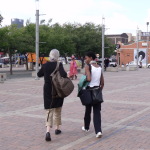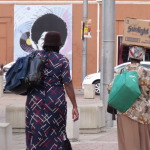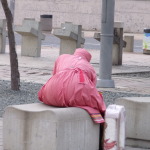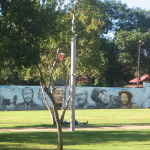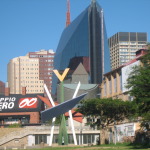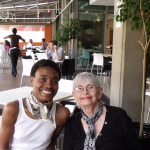Today’s talk is with Musa Hlatshwayo and Acty Tang. There are 20 or more artists present for a lively discussion. Musa talks about the importance of process over product. To develop the work he asked his dancers to do individual research. The focus of their examination has been on the dominant patriarchal system that restricts and oppresses women. Interestingly some version of this theme seems to run through many of the works we are seeing. Musa described the process as “a clearly confused journey.” Having seen the work I would agree. The ideas discussed were not clearly evident to me in the performance. But th opening olo as I said earlier was quite powerful. With a little prodding Musa’s student dancers speak up. Most interesting are their experiences of the creative process and the discovery of how dance could convey complex intellectual constructs. This way of working is opening them to new worlds. Even if they go on to become technologists and doctors they have a fire in their bellies now for dance.
Next we went to lunch with Nelisiwe Xaba to learn more about her current work and investigate the possibility of bringing her to the U.S. Both Marge and I had seen Neli’s duet with Kettly Noel in Tunis two years ago and were completely intrigued. There are proportionately so few women making work in Africa. This is something I want to dig into more. Across Africa it seems that family and social mores strongly dictate professional pursuits and for both men and women dance is not encouraged as a career path. Time and time again I have heard dancers talk about their struggle with parents who did not want them to pursue dance. Not so different from the states in this respect! But clearly the pressure is stronger on women to be mothers and home keepers. Artistic ambition is misunderstood and is frowned upon.
For lunch we went for the first time across Fitzgerald Square, a large open plaza bordered by Museum Africa. Finally with camera in hand I began to document — old women with buckets on heads and young women with babies strapped on back, boys and men of all ages in soccer T-shirts. Interesting murals and graffiti.
The World Cup is coming in 94 days. Everyone is counting down and is incredibly proud that South Africa was chosen to be the site for this major sports event. The stadiums have been completed but there is road construction everywhere and folks don’t seem too optimistic that all will be ready in time for the anticipated crowds. Crime has apparently been reduced dramatically in the last few months with added police and diligence in preparation for games. Signs everyway declare Joburg a world-class city. Hopes are high that the World Cup will really put Joburg on the global map and attract tourism and
investment. I get the sense that everyone is being cautious so that nothing bad happens before June. People encourage us to be escorted arond and not to walk downtown alone.
This afternoon a visit with Gregory Maqoma was planned but as the Festival Curator he is madly busy trying to keep all the artists happy, oversee production rehearsals and stay on top of all the performances. Boy do I know what he is dealing with! No matter, Greg is taking us on a personal tour of Soweto on Monday (our one day off) and we will have lots of car time to catch up.
The performance this evening is a triple bill featuring works by PJ Sabbagha, Moving Into Dance Mophatong, and Acty Tang held in the Barney Simon Theatre, small black box space in the Market Theatre. I had already had a chance to meet and visit with PJ who happens to be friendly with my Bates pal, Michael Foley. The dance world is really so small! Of the three works, PJ’s “Deep Night” stands out. A compelling 20-minute excerpt of a longer work, “Deep Night” deals with man’s desperate desire to belong and be loved. It draws its impulse from the ‘witching hour’ of night when desires become all consuming. A video of dark city streets is projected throughout the work on the back wall and creates ambience without pulling one’s eye and competing with the dancing. The two women, Dada Masilo and Lulu Mlangeni are absolutely fabulous –gutsy, fierce, sexy, provocative dancing. PJ makes clever use of a leaf blower to reveal the legs and panties beneath the flimsy slips worn by the women. Further along newspapers are blown onto the nearly naked body of Dada and later still shredded newsprint is blown in a large quantity to transform the stage space. “Deep Night” left Marge and I wanting to see more and eager to consider a U.S. tour depending on how the full work plays out.
Also on the program is “Dark City,” a powerful work by an entirely new group of dancers from Moving Into Dance, one of the most established companies in Joburg. Choreographed by Themba Mbuli the piece was inspired by Constitution Hill (formerly Old Fort Prison) and created to honor ex-political prisoners who devoted their lives to freedom. The piece conveys the horrors of imprisonment under apartheid. Props included hand and ankle chains that were manipulated into hang ropes. Set to a rhythmic score the choreography uses unison movement to create powerful images of struggle and unity.
Acty Tang, originally from Hong Kong, created a fanciful solo entitled, “Child” that completed the program.
At each program I am missing reading the artist’s bios in the programs. There are none. This is fine if I already know the artist, but when I don’t, I feel less informed that I would like to be. I realize it is a big project to collect and edit all these bios but I feel it is somewhat disrespectful of the artists and leaves the audience without very helpful and intersting information. Something to work on for the future.

